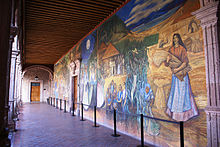Alfredo Zalce

Alfredo Zalce Torres (12 January 1908 – 19 January 2003) was a
Early life
A number of episodes from his childhood have been used to cast light on his future artistic career. Born in Pátzcuaro, Michoacán in 1908, as an infant he lived in Tacubaya during the Mexican Revolution; his school was near where the rival forces of Victoriano Huerta and Emiliano Zapata met in battle. One day he saw a dead body; he says that instead of fear his attitude was that of contemplation.[5] According to a friend and prominent collector of his works, the young Alfredo began to draw aged six or seven, but chose to do so upon the linoleum floor of his home; nevertheless both his parents praised him.[4] While at primary school, he regularly drew on the blackboard to accompany his teachers and illustrate their lessons, as encouragement to his fellow pupils.[5]
Between 1924 and 1927 he studied at the
Career


Much of Zalce's career was spent in teaching and cultural activities.
He was a founder or cofounder of the Escuela de Pintura of Tabasco, the Taller de Gráfica Popular, the Escuela de Pintura of Taxco in Guerrero, the Taller de Artes Plásticas in Uruapan and the Escuela de Pintura y Artesanías in Morelia.[3] He was also a founder of the Liga de Escritores y Artistas Revolucionarios in 1933; one of its first missions was to oppose the favourable attitude at the time of many in Mexico towards Adolf Hitler.[5]
In 1930, he created a mural for the primary school in Ayotla, State of Mexico. In 1932, he worked in "fresco" at the Escuela para Mujeres in Mexico City. He painted murals in the former Talleres Gráficos de la Nación in 1936; again in collaboration with Leopoldo Méndez at the Escuela Normal de Puebla in 1938; and at the Palacio de Gobierno and the Cámera de Diputados in Michoacán with Ángel Bracho in 1948.[3] Between 1961 and 1962 he created the giant mural in bronze relief, History of Morelia, measuring 350 m2, at the Palacio de Gobierno of Michoacán.[6]
He staged his first public exhibition at the José Guadalupe Posada Gallery in Mexico City in 1932.
In 1946 he illustrated a volume of drama and verse by
Zalce declined the
Artistry
Zalce was active in
Museo de Arte Contemporanéo Alfredo Zalce
Museo de Arte Contemporáneo "Alfredo Zalce" (MACAZ) opened in Morelia in 1971. It contains eight or nine halls, of which all but one are used for temporary exhibitions of contemporary art from Mexico and abroad; the last is dedicated to the life and works of Alfredo Zalce. The permanent collection also includes works by Efraín Vargas and others. The museum is housed in a nineteenth-century mansion in the Cuauhtémoc Forest.[11][12]
Personal life and death
He had many "loving lady admirers".[4]
In the mid 1940s he married Frances DuCasse, an American artist from Chicago Illinois USA, who died in the early 1950s. The couple had been living in Mexico City, but had already moved to Morelia. Frances and Alfredo are both included in a group photograph of the primary members of the Taller de Graphica de Popular. This photograph was prominently displayed at the entrance to a major exhibition of TGP work, at the Art Institute of Chicago in 2014.[13][14]
Upon his death aged 95 in 2003, he was cremated at the Panteón Jardínes del Tiempo in Morelia.[3] His former home in the city has been turned into the Alfredo Zalce Foundation to preserve his legacy.[15]
References
- ^ a b c d Rojas, Lorena Rodríguez (22 September 2011). "Alfredo Zalce artista con sentido crítico" [Alfredo Zalce, artist with a critical sense]. Milenio (in Spanish). Mexico City. Archived from the original on 29 January 2013. Retrieved 8 July 2012.
- ^ JSTOR 3109345.
- ^ Instituto Latinoamericano de la Comunicación Educativa. Archived from the originalon 24 March 2012. Retrieved 8 July 2012.
- ^ ISSN 1028-9089. Retrieved 8 July 2012.
- ^ Ciudad Universitaria. 30 December 2002.
- ^ a b "Fue Alfredo Zalce un artista consagrado en la ejecución plástica" [Alfredo Zalco was an artist consecrated to the execution of the plastic arts]. Cambio de Michoacán (in Spanish). Morelia. 12 January 2012. Archived from the original on 16 April 2014. Retrieved 8 July 2012.
- JSTOR 334066.
- JSTOR 664477.
- Secretariat of Public Education. Archived from the originalon 30 January 2012. Retrieved 8 July 2012.
- JSTOR 27934479.
- ^ "Museo de Arte Contemporáneo "Alfredo Zalce"" (in Spanish). Government of Michoacán. n.d. Archived from the original on 16 April 2014. Retrieved 16 April 2014.
- Consejo Nacional para la Cultura y las Artes. Retrieved 8 July 2012.
- ^ Raymond DuCasse, Frances' brother, who lived with them for 4 years.
- ^ Ademas de Prignitz, El Taller de Graphica Popular, page 438.
- ^ Márquez, Carlos F (12 January 2010). "Patronato mantiene en el olvido la casa del pintor Alfredo Zalce" [Forgotten Heritage: the house of painter Alfredo Zalce]. La Jornada de Michoacán (in Spanish). Morelia. Archived from the original on 21 February 2013. Retrieved 8 July 2012.
Further reading
Zalce, Alfredo (et al.) (1999). Alfredo Zalce: artista michoacano (in Spanish). Instituto Michoacano de Cultura. p. 199.





